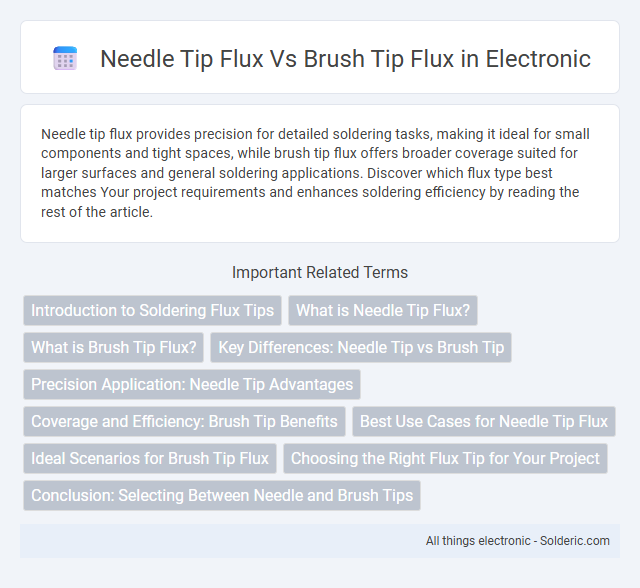Needle tip flux provides precision for detailed soldering tasks, making it ideal for small components and tight spaces, while brush tip flux offers broader coverage suited for larger surfaces and general soldering applications. Discover which flux type best matches Your project requirements and enhances soldering efficiency by reading the rest of the article.
Comparison Table
| Feature | Needle Tip Flux | Brush Tip Flux |
|---|---|---|
| Applicator Type | Needle-shaped, precise application | Brush-shaped, broad and even spreading |
| Application Precision | High precision for small or detailed areas | Moderate precision suitable for larger surfaces |
| Flux Distribution | Controlled, minimal excess flux | Even, covers larger areas quickly |
| Typical Use Cases | Microelectronics, delicate soldering spots | General PCB soldering, rework, cleaning |
| Ease of Use | Requires steady hand, skillful application | User-friendly, faster application |
| Flux Type Compatibility | Compatible with liquid and gel fluxes | Mostly used with gel or paste flux |
| Control Over Quantity | Excellent control, reduces waste | Less control, can apply excess flux |
Introduction to Soldering Flux Tips
Needle tip flux and brush tip flux both serve essential roles in soldering by delivering flux precisely to the joint area, promoting better wetting and reducing oxidation. Needle tip flux offers pinpoint accuracy ideal for fine-pitch components and delicate electronics, while brush tip flux provides broader coverage suitable for larger surfaces and through-hole soldering. Choosing between needle tip and brush tip flux enhances solder joint quality by matching flux application method to specific soldering tasks and component types.
What is Needle Tip Flux?
Needle tip flux is a type of flux dispenser featuring a fine, pointed tip designed for precise application in soldering processes, especially on small or intricate components. It allows controlled release of flux, enhancing joint quality by preventing excess flow and minimizing contamination. This precision is critical in delicate electronic assemblies where accurate flux placement directly impacts solder joint reliability.
What is Brush Tip Flux?
Brush tip flux is a type of flux applied using a small brush, allowing precise and controlled application directly onto solder joints or components. It ensures accurate coverage and reduces the risk of excess flux spreading, making it ideal for delicate electronics assembly or rework. You benefit from its ease of use when targeting specific areas without affecting surrounding parts.
Key Differences: Needle Tip vs Brush Tip
Needle tip flux offers precise application with a fine, concentrated flow ideal for detailed soldering tasks, while brush tip flux provides broad coverage suitable for larger surface areas. The needle tip design minimizes flux wastage and ensures targeted placement, enhancing control during delicate electronics work. In contrast, brush tip flux allows easier spreading but may result in less accuracy and increased flux residue.
Precision Application: Needle Tip Advantages
Needle tip flux offers superior precision application compared to brush tip flux, allowing you to target small, intricate solder joints with minimal spillage. Its fine, pointed design delivers controlled flux flow, reducing waste and enhancing accuracy during electronic assembly or repair. This precision minimizes the risk of flux contamination on adjacent components, improving overall solder quality and reliability.
Coverage and Efficiency: Brush Tip Benefits
Brush tip flux provides superior coverage and efficiency compared to needle tip flux, making it ideal for soldering larger surface areas quickly. Its broader applicator allows for even distribution of flux, reducing application time and ensuring consistent solder joints. You can achieve faster workflow and improved solder quality with brush tip flux in electronics assembly or repair tasks.
Best Use Cases for Needle Tip Flux
Needle tip flux is ideal for precision soldering tasks requiring fine control and minimal flux application, commonly used in electronics assembly such as surface-mount device (SMD) soldering and delicate circuit board repairs. Its concentrated dispensing allows for targeted flux delivery, reducing the risk of flux residue and improving solder joint quality on small, intricate components. Compared to brush tip flux, needle tip flux excels in controlled environments where accuracy and cleanliness are crucial.
Ideal Scenarios for Brush Tip Flux
Brush tip flux is ideal for applications requiring broad, even coverage on larger surfaces or when working with intricately shaped components. It allows you to control the amount of flux applied, reducing waste and preventing excess residue that might compromise solder joints. This type of flux is particularly suitable for PCB assembly and rework tasks where precision and consistency are essential.
Choosing the Right Flux Tip for Your Project
Choosing the right flux tip is crucial for achieving precise soldering results; needle tip flux offers pinpoint accuracy ideal for intricate electronics, while brush tip flux provides broader coverage suited for larger joints. Needle tips minimize excess flux application, reducing the risk of short circuits in delicate components. Brush tips ensure efficient flux distribution on bigger surfaces, enhancing solder flow and joint strength in general electrical or plumbing work.
Conclusion: Selecting Between Needle and Brush Tips
Selecting between needle tip flux and brush tip flux depends on the specific soldering application and precision required. Needle tip flux offers superior accuracy for fine or intricate soldering tasks, ensuring minimal spread and clean joints. Brush tip flux is ideal for larger surfaces or general-purpose soldering, providing efficient flux application with good coverage and ease of use.
Needle tip flux vs brush tip flux Infographic

 solderic.com
solderic.com